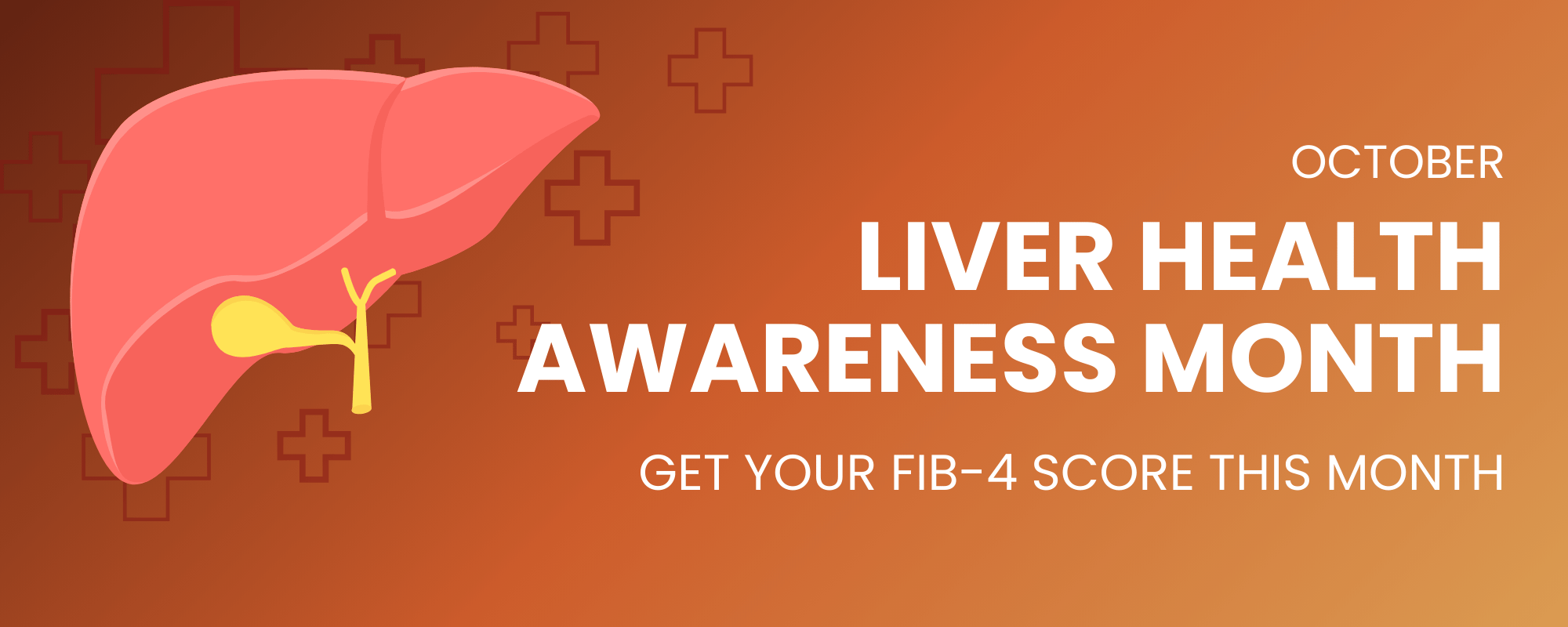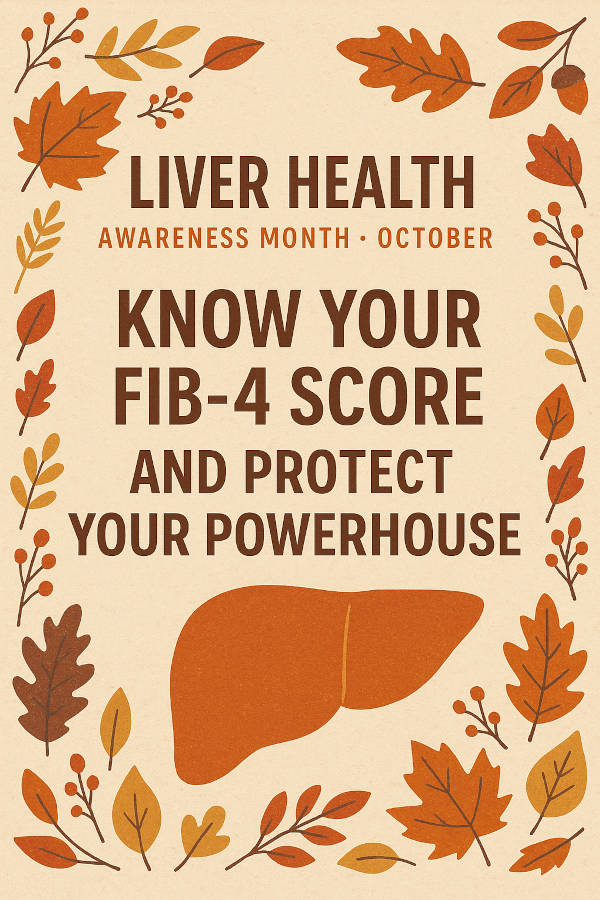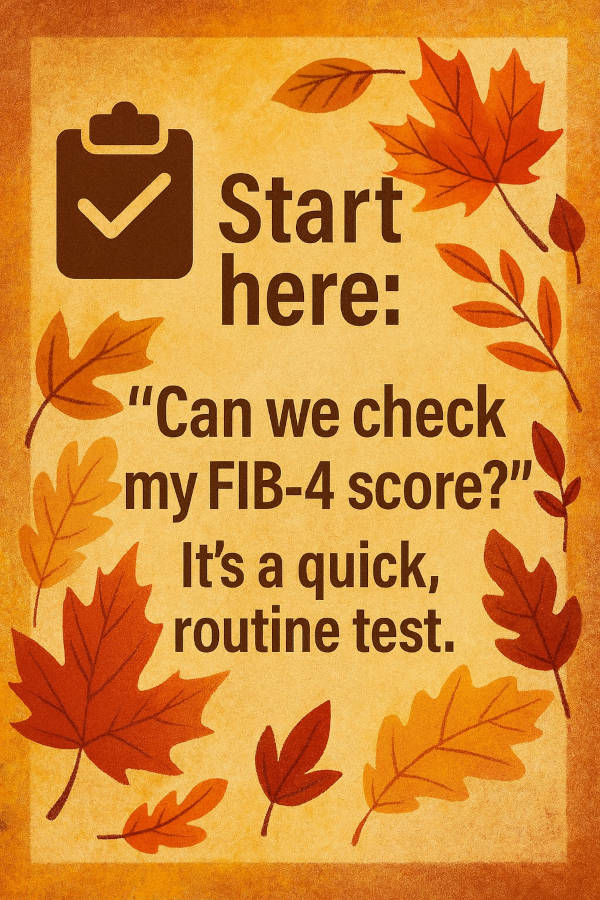
Liver disease doesn’t have to be a silent threat.
By knowing your FIB-4 Score, making healthy lifestyle choices, and working with your healthcare provider, you can protect your powerhouse for years to come.
This October — Take Action!

Know Your FIB-4 Score — Protect Your Powerhouse, Protect Your Future
One simple tool your doctor can use to check for liver scarring is the FIB-4 Score.
- What it is: A calculation based on your age and routine blood tests — Liver Enzymes (AST & ALT), and blood platelet count — to estimate the likelihood of liver fibrosis.
- Why it’s important: The FIB-4 Score can identify people at higher risk for advanced liver disease, even if they have no symptoms.
- But I don’t drink so why would I be at risk: More people are getting what is called non-alcoholic liver disease (often referred to as MASLD or NALFD) typically caused from diet, specifically too much added sugar and processed food.
- Wouldn’t I feel sick if I have liver disease? Often times liver disease doesn’t present symptoms until it is far advanced which is why early detection and screening is important. The FIB-4 is simple, easily accessible and inexpensive and can be done at the primary care doctor level without seeing a specialist.
We track our blood pressure, cholesterol, blood sugar and more… so why not our liver health too? You should KNOW YOUR FIB-4 SCORE!
How to Ask Your Doctor for Your FIB-4 Score
- Request the labs: Ask for a blood panel that includes Liver Enzymes (AST & ALT), and blood platelet count.
- Calculate your score: Your doctor can do this for you, or you can use a reputable online FIB-4 calculator, like the one we recommend on MDCalc.
- Discuss next steps:
- A low score (<1.3) usually means no significant scarring. The recommendation is to periodically repeat the FIB-4, ideally annually when you go for an annual physical.
- An intermediate score (1.3-2.6) usually means there could be scarring. Additional testing is highly recommended, typically a non-invasive test such as a FibroScan®, or a blood-based test like the ELF® test. You can learn more about non-invasive tests (NITs) and the differences between each on our NIT page. Further testing may require a referral to a Hepatologist.
- A higher score (>2.6) indicates advanced risk for advanced liver fibrosis. It is important to ask to be referred to a Hepatologist for further testing and counseling.
At Liver Education Advocates we also offer an online Liver Disease Support Group that meets three times a month and is open to patients, caregivers, family members or anyone impacted by any type of liver disease. Learn more about our Liver Disease Support Group.

Liver Health Awareness Month: Why October Is the Time to Protect Your Powerhouse
Introduction
October is Liver Health Awareness Month, a time to shine a light on one of the body’s hardest-working but most overlooked organs. Your liver filters toxins, stores energy, and helps digest nutrients, yet liver disease often develops silently without obvious symptoms until it’s advanced, making early detection essential.
Understanding Fatty Liver Disease (MASLD & MASH)
Metabolic dysfunction associated steatotic liver disease (MASLD, formerly NAFLD) and metabolic dysfunction associated steatohepatitis (MASH, formerly NASH) affect millions of people without them knowing.
- MASLD: Fat accumulates in the liver, often linked to excess weight, type 2 diabetes, and high cholesterol.
- MASH: A more severe stage with inflammation and liver cell damage, leading to fibrosis (scarring).
Key Fact: Most people with MASLD or MASH have no symptoms until serious damage occurs.
Why You Should Know Your FIB-4 Score
The FIB-4 Score is a simple calculation that helps doctors estimate the level of fibrosis in your liver. It uses:
- Your age
- AST (aspartate aminotransferase)
- ALT (alanine aminotransferase)
- Platelet count
A higher score can indicate a higher risk of advanced scarring, prompting further testing such as FibroScan® or MRI.
How to Get Your FIB-4 Score
- Ask your doctor for a blood test that includes AST, ALT, and platelet count.
- Have your doctor calculate your FIB-4 score or use a trusted online calculator.
- Discuss results and determine whether additional screening is needed.
Taking Action This October
- Get screened for fatty liver disease if you have risk factors like obesity, diabetes, or high cholesterol.
- Know your FIB-4 Score and track it over time.
- Make healthy lifestyle changes, balanced diet, regular exercise, limited added sugar and alcohol.
Bottom Line
Liver disease can be silent, but your response doesn’t have to be. This October, take charge of your liver health, because protecting your powerhouse means protecting your future.
Check Your FIB-4 Score TodayThe Hidden Threat: Fatty Liver Disease (MASLD & MASH)
Your liver is your body’s powerhouse — working 24/7 to filter toxins, process nutrients, store energy, and keep you healthy. Yet, liver disease often develops silently, without obvious symptoms, until it’s advanced. One of the best things you can do to keep your liver healthy is to avoid or reduce the amount of processed food and foods with added sugar you consume. Learn more about lifestyle impact on liver health on our Lifestyle webpage.
Most people are also unaware that left undiagnosed and untreated, fatty liver disease not only has the potential to progress to cirrhosis but also to liver cancer.

Metabolic dysfunction–associated steatotic liver disease (MASLD, formerly nonalcoholic fatty liver disease, NAFLD) and metabolic dysfunction–associated steatohepatitis (MASH, formerly nonalcoholic steatohepatitis, NASH) are among the most common liver diseases worldwide.
- MASLD occurs when excess fat builds up in the liver, often linked to factors like obesity, type 2 diabetes, and high cholesterol.
- MASH is a more severe form where inflammation and liver cell damage can lead to scarring (fibrosis) and, over time, cirrhosis or liver cancer.
Why it matters: Most people with MASLD or MASH typically have no symptoms until serious damage has occurred. You can feel fine and still have significant liver disease. That’s why screening and early detection are critical.


